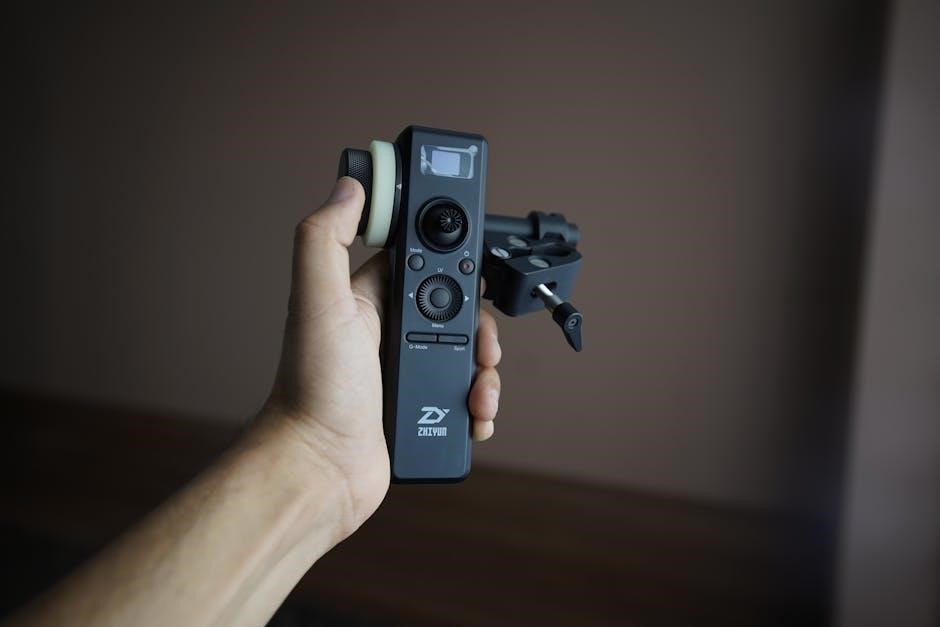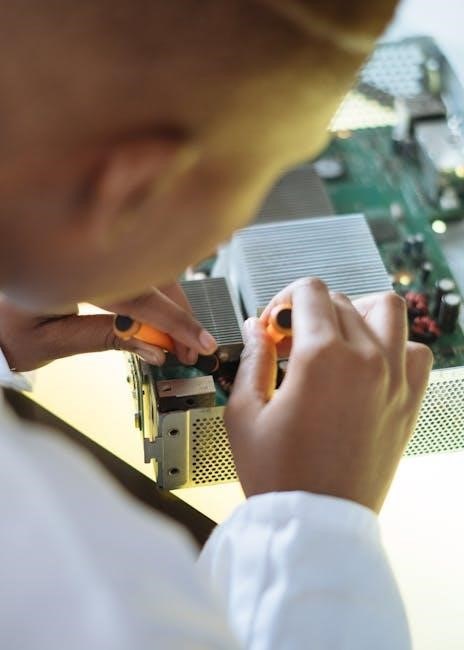The Dixell Controller Manual PDF is a comprehensive guide for operating and programming Dixell controllers, covering models like XR01CX, XW220L, and XR06CX․ It provides essential information on installation, configuration, and troubleshooting, ensuring optimal performance in refrigeration and heating applications․ The manual is designed for technicians and users, offering detailed insights into system setup, advanced features, and maintenance tips․
Overview of Dixell Controllers
Dixell controllers are advanced, microprocessor-based devices designed for precise temperature and humidity control in various applications․ Models like XR01CX, XW220L, and XR06CX cater to different needs, offering single-stage or multi-stage control․ They are widely used in refrigeration, heating, and ventilation systems, ensuring efficient and reliable performance․ These controllers are known for their versatility, suitability for both small and large-scale installations, and compatibility with diverse industrial and commercial environments․ Their compact designs and user-friendly interfaces make them ideal for integrating into existing systems while maintaining high operational standards․
Importance of the Manual for Users
The Dixell Controller Manual PDF is an indispensable resource for users, providing detailed instructions for installation, operation, and troubleshooting․ It ensures proper setup and configuration, maximizing system efficiency and safety․ The manual offers clear guidelines for understanding controller features and addressing common issues, which is crucial for maintaining optimal performance․ By following the manual, users can avoid operational errors and prolong the lifespan of their controllers․ This comprehensive guide is essential for both novice and experienced users, serving as a quick reference for resolving queries and ensuring smooth functionality of Dixell controllers in various applications․
Structure and Content of the Manual
The Dixell Controller Manual PDF is organized into clear sections, ensuring easy navigation for users․ It begins with general warnings and safety precautions, followed by a detailed description of the controller’s features and functions․ The manual covers regulatory settings, defrost management, and fan control, providing step-by-step guides for installation and configuration․ Advanced features like XWEB remote management and data logging are also explained․ Additional sections include troubleshooting tips, maintenance recommendations, and compliance information, ensuring comprehensive coverage of all aspects of Dixell controllers․ This structured approach makes the manual an invaluable resource for both setup and ongoing operation․

Installation and Setup
The manual provides detailed hardware and software requirements for Dixell controller installation, ensuring compatibility with various refrigeration and heating systems․ It guides through setup procedures seamlessly․
Hardware Requirements for Installation
The Dixell controller manual outlines specific hardware requirements for installation, including compatible sensors, relays, and wiring․ It ensures that users select the right components for optimal performance․ Proper hardware setup is crucial for reliable operation in refrigeration and heating systems․ The manual also specifies the physical dimensions of controllers, such as the XR01CX model, which measures 32x74x50 mm, and the XW220L model, which measures 38×185 mm․ Adhering to these requirements guarantees smooth integration and functionality․
Software Requirements for Programming
The Dixell controller manual specifies software requirements for programming, emphasizing compatibility with XWEB management tools․ Desktop software requires a PC with suitable operating systems, while mobile versions support smartphones and tablets․ The manual details how to use XWEB for remote monitoring and control, enabling data logging and alarm management․ Software requirements ensure seamless integration with Dixell controllers, such as XR01CX and XW220L models, for advanced programming and customization․ Proper software setup is essential for maximizing the controller’s functionality and ensuring efficient system operation․
Step-by-Step Installation Guide
The manual provides a detailed installation guide for Dixell controllers, ensuring a smooth setup process․ Begin by mounting the controller in a suitable location, adhering to environmental specifications․ Next, connect the wiring according to the diagram, ensuring proper power supply and sensor connections․ Install the necessary software, such as XWEB, to enable remote management․ Configure the controller settings based on the application, such as refrigeration or heating modes; Test the system to verify functionality and ensure all alarms and monitoring features are active․ Finally, review the setup for accuracy and perform a final system check to confirm optimal performance․

Operating the Dixell Controller
Operating the Dixell Controller is straightforward, with an intuitive interface for navigating settings and monitoring functions․ Users can easily adjust temperature, toggle modes, and access alarms․
User Interface and Navigation
The Dixell Controller features an intuitive user interface with a clear LCD display, making navigation seamless․ The front panel buttons provide easy access to settings, modes, and alarms․ Users can quickly adjust parameters, monitor real-time data, and toggle between operating modes․ The menu structure is logical, ensuring smooth navigation through various functions․ Remote management via XWEB software enhances accessibility, allowing adjustments and monitoring from a connected device․ The interface is designed for efficiency, ensuring users can perform tasks without complexity, making it ideal for both novice and experienced operators․
Basic Operating Modes
The Dixell Controller operates in several basic modes, including heating, cooling, and standby, tailored for precise temperature regulation․ These modes ensure optimal performance in refrigeration and heating applications․ The manual details how to select and configure these modes, enabling users to adapt the controller to specific demands․ For instance, the cooling mode is ideal for maintaining low temperatures, while the heating mode ensures consistent warmth․ The standby mode conserves energy when active operation isn’t required․ The manual provides clear instructions on switching between modes and customizing settings for efficient operation, ensuring users can easily manage their systems․
Advanced Features and Functions
The Dixell Controller offers advanced features like programmable parameters, remote management via XWEB, and data logging capabilities․ Users can monitor and adjust settings in real-time, ensuring precise temperature control․ The system supports custom configurations, enabling tailored solutions for specific applications․ Advanced monitoring tools provide detailed insights into performance metrics, while integration with data logging systems enhances record-keeping․ These features allow for seamless scalability and adaptability, making the Dixell Controller a versatile option for complex environmental control needs․ The manual provides detailed guidance on leveraging these advanced functionalities effectively․ This ensures optimal performance and efficiency in various industrial and commercial settings․

Programming and Configuration
Programming and configuration of Dixell controllers involve setting parameters for precise temperature control, enabling custom configurations, and utilizing XWEB for remote management and monitoring capabilities․
Understanding Programming Parameters
Programming parameters are essential for customizing Dixell controller operations, enabling precise temperature and humidity control․ These parameters define settings like temperature setpoints, defrost cycles, and alarm thresholds․ Understanding them allows users to tailor the controller’s behavior to specific applications, ensuring optimal performance․ Parameters can be adjusted via the user interface or XWEB software, offering flexibility for different operating conditions․ Proper configuration is crucial for maintaining efficiency and preventing system malfunctions, making it a key focus in the manual․
Setting Up Custom Configurations
Setting up custom configurations on Dixell controllers allows users to tailor settings to specific applications․ Using the XWEB software or the controller’s interface, parameters like temperature ranges, defrost timings, and fan speeds can be adjusted․ The manual guides users through creating customized configurations, ensuring optimal performance for their systems․ Custom settings can be saved and reused across multiple units, streamlining operations․ This feature enhances adaptability, making Dixell controllers suitable for diverse refrigeration and heating needs, while maintaining precision and efficiency in varying environmental conditions․
Using XWEB for Remote Management
XWEB provides advanced remote management capabilities for Dixell controllers, enabling real-time monitoring and control․ Users can access data monitoring, adjust parameters, and receive alarm notifications via desktop or mobile devices․ The software allows for remote configuration and updates, ensuring seamless system management․ With XWEB, users can monitor multiple controllers simultaneously, streamline operations, and ensure optimal performance․ This feature enhances efficiency and reduces the need for on-site interventions, making it ideal for managing distributed systems effectively․
Troubleshooting and Maintenance
The manual provides guidance on identifying and resolving common issues, performing routine maintenance, and updating firmware to ensure optimal controller performance and reliability over time․
Common Issues and Solutions
The manual addresses common issues such as sensor malfunctions, communication errors, and firmware glitches․ Solutions include recalibrating sensors, restarting the controller, and updating software․ For example, if the display shows incorrect temperatures, users should check sensor connections and ensure proper calibration․ Communication issues can often be resolved by verifying network settings or restarting connected devices․ Firmware updates are recommended to fix bugs and improve performance․ Regular maintenance, such as cleaning sensors and updating software, helps prevent these issues․ The guide provides step-by-step instructions for troubleshooting and resolving problems efficiently, ensuring optimal system operation․
Maintenance Tips for Optimal Performance
Regular maintenance is crucial for ensuring the Dixell controller operates efficiently․ Clean the controller and sensors periodically to prevent dust buildup, which can affect accuracy․ Check and tighten connections to avoid signal disruptions․ Update firmware and software regularly to access new features and bug fixes․ Inspect wiring for damage or wear and replace as needed․ Perform routine system checks to identify potential issues early․ Schedule periodic calibration of sensors to maintain precise temperature and humidity control․ Proper maintenance ensures reliable performance, extends the lifespan of the controller, and minimizes downtime in critical applications․
Updating Firmware and Software
Regularly updating the firmware and software of your Dixell controller is essential for optimal functionality․ Updates often include performance improvements, new features, and bug fixes․ Use the XWEB platform to download and install the latest versions․ Ensure a stable power supply during updates to prevent interruptions․ Refer to the manual for step-by-step instructions tailored to your specific model․ Updating ensures compatibility with the latest systems and maintains peak performance․ Always verify the source of updates to avoid unauthorized or corrupted files, which could compromise system integrity․ Keep your controller up-to-date for enhanced reliability and advanced feature support․

Specific Models and Their Features
The Dixell Controller Manual PDF details models like XR01CX, XW220L, and XR06CX, each designed for specific applications in refrigeration, heating, and humidity control, ensuring tailored performance․
XR01CX Model Overview
The XR01CX is a single-stage temperature controller designed for refrigeration and heating applications․ It features a compact 32x74x50 mm format, making it ideal for space-constrained installations․ With microprocessor-based technology, it offers precise temperature regulation and reliability․ The controller supports defrost and fan management, essential for maintaining optimal conditions in refrigeration systems․ Its user-friendly interface and compatibility with XWEB software enable remote monitoring and configuration․ Suitable for medium or low-temperature units, the XR01CX is a versatile solution for various commercial refrigeration needs, ensuring efficient and consistent performance․
XW220L Model Capabilities
The XW220L is a microprocessor-based controller designed for normal temperature refrigeration units, featuring a compact 38×185 mm format․ It offers advanced temperature regulation, defrost management, and fan control․ The controller supports data monitoring and alarm detection, ensuring efficient system oversight․ Compatible with XWEB software, it allows remote monitoring and configuration․ Ideal for commercial refrigeration, the XW220L provides precise control, reliability, and ease of use, making it a robust solution for maintaining optimal refrigeration conditions in various applications;
XR06CX Model Specifications
The XR06CX is a microprocessor-based controller designed for medium or low temperature ventilated refrigeration units․ With dimensions of 32x74x60 mm, it offers precise temperature control and advanced features․ The controller supports data monitoring, alarm detection, and remote management via XWEB software․ It is ideal for applications requiring reliable performance in demanding environments․ The XR06CX ensures efficient operation, easy configuration, and compatibility with various refrigeration systems, making it a versatile solution for commercial and industrial cooling needs․

Temperature and Humidity Control
Dixell controllers provide precise temperature and humidity management, ideal for refrigeration, heating, and freezing applications․ They ensure stable conditions, optimizing performance in various environmental control systems effectively․
Refrigeration and Heating Applications
Dixell controllers are widely used in refrigeration and heating systems, offering precise temperature control for various applications․ From industrial refrigeration units to commercial heating systems, these controllers ensure optimal performance․ They support single-stage temperature control, making them suitable for both cooling and heating environments․ With advanced features like defrost management and fan control, Dixell controllers maintain consistent temperatures, preventing overheating or overcooling; Their compatibility with different system configurations ensures reliable operation in diverse settings, making them a preferred choice for temperature-sensitive applications․
Humidity Control in Freezing Cabinets
Dixell controllers provide advanced humidity control solutions for freezing cabinets, ensuring optimal storage conditions․ By maintaining precise humidity levels, they prevent frost buildup and keep products fresh․ The controller’s digital inputs and outputs enable seamless integration with humidity sensors and fans, allowing automated adjustments․ This feature is crucial for applications requiring consistent humidity, such as food storage and medical equipment․ The manual details how to configure these settings, ensuring efficient operation and preventing damage to stored items․ Proper humidity control extends shelf life and maintains product quality in freezing environments․
Defrost and Fan Management
Dixell controllers offer robust defrost and fan management capabilities, ensuring efficient operation in refrigeration systems․ The manual details how to configure defrost cycles, preventing ice buildup and maintaining optimal performance․ Fan management features allow precise airflow control, reducing energy consumption and ensuring consistent temperatures․ Automated defrost timing and fan speed adjustments can be programmed based on specific application needs․ The controller’s digital inputs enable integration with defrost sensors, while the user interface provides real-time monitoring and adjustments․ These features are essential for maintaining system efficiency, preventing overheating, and extending equipment lifespan in demanding environments․

Alarm and Monitoring Systems
Dixell controllers feature advanced alarm detection and data monitoring, ensuring real-time system supervision․ The manual details how to configure alarms, log data, and receive remote notifications for optimal system performance and quick issue resolution․
Alarm Detection and Recording
The Dixell controller manual PDF details how the system detects and records alarms, ensuring timely responses to issues․ It explains how alarms are triggered by specific conditions, such as temperature deviations or system malfunctions․ The manual provides step-by-step guidance on configuring alarm settings, viewing alarm history, and understanding alarm priorities․ Users can set custom thresholds for temperature, humidity, and other parameters to tailor alarm responses to their needs․ Additionally, the system allows for remote notifications, enabling users to address issues promptly․ This feature enhances monitoring efficiency and minimizes downtime in refrigeration and heating applications․
Data Monitoring and Logging
The Dixell controller manual PDF outlines robust data monitoring and logging capabilities, enabling users to track temperature, humidity, and system performance in real time․ The system allows for detailed data collection, storage, and analysis, with options to view historical trends and generate reports․ Users can configure logging intervals and set thresholds for specific parameters, ensuring precise monitoring․ The manual also explains how to access logged data via the user interface or remote platforms like XWEB, facilitating efficient system management and performance optimization in refrigeration and heating applications․ This feature is essential for maintaining operational efficiency and compliance with industry standards․
Remote Alarm Notifications
The Dixell controller manual PDF details the remote alarm notification system, enabling real-time alerts for critical events such as temperature deviations or system malfunctions․ Through XWEB, users can configure notifications to be sent via email or SMS, ensuring prompt responses to issues․ The manual explains how to set up custom alerts based on alarm severity and specific parameters, allowing for tailored monitoring․ This feature enhances operational efficiency by enabling proactive maintenance and minimizing downtime․ Remote notifications are particularly useful for large-scale systems, where on-site monitoring is impractical, ensuring continuous oversight and rapid troubleshooting capabilities․ This ensures optimal system performance and reliability․
System Integration and Connectivity
Dixell controllers offer seamless integration with various devices, supporting communication protocols like Ethernet, RS485, and Modbus․ Compatibility with third-party systems ensures enhanced connectivity for comprehensive control solutions․
Connecting to Other Devices
Dixell controllers support integration with various devices via protocols like Modbus, Ethernet, and RS485, enabling communication with sensors, actuators, and other control systems․ The manual provides detailed instructions for connecting these devices, ensuring proper wiring and configuration․ This connectivity allows for seamless monitoring and control of temperature, humidity, and other parameters across multiple units․ By following the guidelines, users can establish reliable connections, enhancing system performance and scalability․ Proper setup ensures data accuracy and efficient operation, making it essential to adhere to the manual’s instructions for optimal results․
Network Configuration Options
The Dixell controller manual PDF outlines various network configuration options, enabling users to set up IP addresses, subnet masks, and gateways for seamless communication․ It guides configuring DNS and DHCP settings to ensure devices connect securely to the network․ The manual also details how to establish remote monitoring and control using XWEB software, allowing centralized management of multiple controllers․ Additionally, it covers configuring network security features, such as passwords and access controls, to safeguard the system․ These options ensure reliable data exchange and efficient system integration, making network setup straightforward and customizable for different applications․
Compatibility with Third-Party Systems
The Dixell controller manual PDF emphasizes the compatibility of Dixell controllers with third-party systems, ensuring seamless integration with various industrial and commercial devices․ It highlights how controllers like the XR01CX and XW220L can connect to external systems using standard communication protocols such as Modbus or BACnet․ The manual provides guidance on configuring these connections to enable data exchange and centralized control․ Additionally, it discusses compatibility with building management systems (BMS) and IoT platforms, allowing for enhanced monitoring and automation․ This ensures Dixell controllers can be easily incorporated into existing infrastructure, offering flexibility and scalability for diverse applications․

Compliance and Safety
The Dixell controller manual PDF outlines essential safety precautions and compliance standards, ensuring safe installation and operation of controllers like XR01CX and XR06CX․ It adheres to industry regulations and environmental considerations, providing guidelines to prevent hazards and maintain optimal performance․
Safety Precautions for Installation
When installing Dixell controllers, such as the XR01CX or XR06CX, it is crucial to follow safety guidelines to prevent electrical hazards․ Ensure the power supply is disconnected before starting installation․ Use appropriate protective equipment, including gloves and safety glasses․ Avoid installing the controller in environments with high humidity or extreme temperatures․ Properly ground the device to prevent electrical shocks․ Refer to the manual for specific warnings and precautions tailored to your model․ Adhering to these guidelines ensures a safe and successful installation process, maintaining both user safety and system reliability․
Compliance with Industry Standards
Dixell controllers, including models like XR01CX and XW220L, are designed to meet rigorous industry standards, ensuring reliability and safety․ They comply with international regulations for electrical and electronic equipment, guaranteeing compatibility and performance across various applications․ The devices adhere to environmental standards, minimizing ecological impact․ Compliance with these standards is verified through extensive testing and certification processes․ This ensures that Dixell controllers are suitable for global markets and can be integrated into diverse systems without compromising on quality or safety․ Adherence to industry standards underscores Dixell’s commitment to producing high-performance, reliable control solutions․
Environmental Considerations
Dixell controllers are designed with environmental sustainability in mind․ They optimize energy consumption, reducing operational waste and minimizing ecological impact․ The devices are constructed using environmentally responsible materials and processes, aligning with global sustainability goals․ Additionally, Dixell controllers comply with regulations aimed at reducing hazardous substances in electronic devices․ Proper disposal and recycling guidelines are provided to ensure minimal environmental impact at the end of the product lifecycle․ These considerations reflect Dixell’s commitment to eco-friendly solutions while maintaining high performance and reliability in refrigeration and heating applications․

Advanced Features and Customization
Dixell controllers offer customizable parameters and settings, enabling tailored configurations for specific applications․ Advanced monitoring and reporting features enhance operational insights, while integration with data logging systems provides comprehensive control and analysis capabilities․
Customizable Parameters and Settings
Dixell controllers allow users to customize parameters such as temperature setpoints, defrost intervals, and fan speeds to suit specific applications․ Models like XR01CX and XW220L offer adjustable settings for refrigeration and heating modes, ensuring precise control․ The XWEB software enables remote configuration of these parameters, providing flexibility for system optimization․ Users can also define custom alarms and thresholds, enhancing operational safety․ These customizable features ensure that Dixell controllers can be tailored to meet the unique demands of various environments, from refrigeration units to humidity-controlled cabinets․
Advanced Monitoring and Reporting
Dixell controllers offer advanced monitoring capabilities, enabling real-time tracking of temperature, humidity, and system performance․ The XWEB software allows users to access detailed logs and generate reports on operational data․ Remote monitoring ensures timely detection of anomalies, while customizable dashboards provide insights into key metrics․ Historical data can be exported for further analysis, aiding in system optimization․ These features enhance decision-making and ensure efficient management of refrigeration and heating systems, making Dixell controllers a robust solution for precise environmental control and compliance monitoring․
Integration with Data Logging Systems
Dixell controllers seamlessly integrate with data logging systems, enabling comprehensive data collection and storage․ The MCT-DX system, for instance, combines refrigeration control with video/chart recording and data logging․ Users can export historical data for detailed analysis, ensuring optimal system performance․ Compatibility with third-party software allows for enhanced data management․ This integration supports remote access, enabling users to monitor and retrieve logs from anywhere․ The system stores data on temperature, humidity, and alarms, providing valuable insights for maintenance and troubleshooting․ This feature-rich integration enhances operational efficiency and compliance with industry standards․

FAQs and Common Queries
The Dixell Controller Manual addresses common queries about compatibility, troubleshooting, and best practices․ It clarifies misconceptions and provides solutions for optimal performance and system integration․
Frequently Asked Questions
Users often inquire about compatibility with specific models like XR01CX and XW220L․ Questions also arise about XWEB management capabilities and troubleshooting common issues․ Many seek clarity on defrost management and fan control settings․ Others ask about data monitoring and alarm notifications․ Some wonder about the best practices for system integration and network configuration․ Additionally, there are queries regarding software updates and environmental compliance․ These FAQs address common concerns, ensuring users can optimize their Dixell controller’s performance and resolve issues efficiently․
Clarifications on Common Misconceptions
Some users believe Dixell controllers are solely for refrigeration, but they also support heating applications․ Others think XWEB is only for desktops, yet it works on mobile devices too․ A common myth is that firmware updates are complex, but the manual simplifies the process․ Another misconception is that all models require advanced programming, whereas basic modes are user-friendly․ Additionally, many assume compatibility issues with third-party systems, but the controllers are designed for seamless integration․ These clarifications help users understand the full capabilities and ease of use of Dixell controllers․
Best Practices for Usage
Regularly update firmware and software to ensure optimal performance․ Always refer to the manual for specific model instructions, such as XR01CX or XR06CX․ Use XWEB for remote monitoring and adjustments, reducing on-site visits․ Schedule periodic maintenance to prevent hardware issues․ Test configurations in safe modes before full deployment․ Backup settings before making significant changes․ Ensure compatibility with third-party systems to avoid integration problems․ Follow safety precautions during installation to prevent damage or hazards․ Keep the manual accessible for quick reference․ Monitor system performance regularly to address potential issues early․ These practices ensure efficient, reliable, and safe operation of Dixell controllers․

